Below is an excerpt from a commentary originally posted at www.speculative-investor.com on 7th July, 2010.
Great credit expansions prompt investment decisions that only make sense within the fantasy-world created by a relentless deluge of new money. When the flow of new money slows or when the true nature of the inflation-fueled boom becomes apparent to a critical mass of people, many of the investments prompted by the easy money fail and the economy enters a recession. If the government then 'fights' the adjustment process by propping-up prices and dramatically increasing its own indebtedness, the recession will potentially transform into a depression. For example, it was most likely the government's response to the post-1929 and post-1990 economic downturns in the US and Japan, respectively, that converted recessions into depressions (where a depression is defined as more than a decade of slow, or no, real economic progress).
Being rife with mal-investments encouraged by a seemingly endless flow of new money and credit, China's economy has been acutely vulnerable for some time. It could have remained superficially strong as long as the government was willing to promote further credit expansion or until inflation risk became a widespread concern, but it was just a matter of time before the gross misdirection of resources started to take a visible toll. As it turned out, the combination of a steeper upward trend in the prices of food and other essentials, obvious bubbles in the residential real estate markets of several major Chinese cities and blatant over-building in the commercial property sector pushed China's policy-makers into crimping the flow of new credit during the first half of this year. The result is a growing pile of evidence that China's economy is now in a slump. For example, the following information was included in Joan McCullough's morning comment to the clients of East Shore Partners on 30th June:
"...if you look at one month interbank rates in Shanghai, you will see that they have climbed steadily up to 4%. While the one-year interest rate is only 1%. Uh-oh. Houston, we have a problem.
And evidently, talk is that domestic liquidity is very tight as foreign capital inflows have stopped. And as a stillpegged currency, M1 expansion (Renminbi) has also stopped. Meanwhile, they are experiencing inflation which has the US dollar trading at a premium in the black market as compared to where it is trading officially. This is not good. None of it. Money quietly flowing out. As a matter of fact, some even suggest that the $2.4 tril in dollar reserves which the world is always trying to pinpoint and which we all automatically, unquestioningly attribute to trade surplus are not what they appear. Rather, some cognoscenti suggest that perhaps less than half that number is attributable to trade. The balance? How about "borrowed" from global speculators?
Anecdotally local iron ore traders kid that the present is a good time for them to take vacation as things are so slow. Steel prices, as a matter of fact, have fallen for 7 weeks. And the car inventory distribution channels are said to be 6-months stuffed but this has been camouflaged. Because "reported car sales" are being counted exfactory, not as final sales."
We knew of the downward trend in steel prices and the proclivity of China's official bean-counters to count a consumer good as "sold" as soon it leaves the factory. We also knew that China's vaunted currency reserve stems from speculative capital flows in addition to trade flows. We didn't know about the elevated level of one-month SHIBOR (Shanghai Inter-Bank Offered Rate) relative to one-year SHIBOR, although we note -- by referring to http://www.shibor.org/shibor/web/html/index_e.html -- that the gap between these rates has since contracted to around 0.2%. And we didn't know -- and haven't been able to verify -- that the US$ has recently traded in the black market at a premium to its official exchange rate against the Yuan.
Interestingly, a lot of people are still citing the "China story" as a reason to be bullish on industrial commodities. The completely bogus GDP numbers spewed out by China's 'ministry of information' help foster such beliefs, but you don't have to dig far beneath the surface to find evidence of an economy in trouble.
That being said, the unusually high level of control that China's government exerts over the rate of credit expansion in both the private and public sectors means that it will be important to stay alert for signs of a policy shift from 'tightening' to 'easing'. To put it another way, we shouldn't under-estimate the Chinese government's ability to re-ignite the inflation-fueled boom. When the next policy-shift occurs in China it will probably be time to turn intermediate-term bullish on industrial commodities, but right now the outlook remains bearish because China is still headed down the 'tightening' path and the rate of global economic growth is slowing.
Here are a few ideas on how to hedge against or speculate on additional weakness in China's economy, especially if equity markets rebound over the coming days (a rebound would create a better opportunity to enter bearish positions):
1. Buy put options on the stocks of major industrial-metal producers such as FCX and VALE (as one of the world's largest iron-ore and nickel producers, VALE would be hurt by further weakening in the demand for steel).
2. Buy BZQ (a leveraged fund that moves inversely to the Brazilian stock market) or put options on EWZ (iShares Brazil).
3. Short the A$ or buy A$ (FXA) put options.
We aren't offering a free trial subscription at this time, but free samples of our work (excerpts from our regular commentaries) can be viewed at: http://www.speculative-investor.com/new/freesamples.html
















